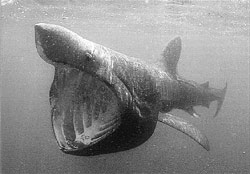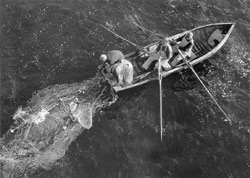Most victims were attacked in surf where the shark mistook them for their favorite prey. In the U.S. most shark attacks occur in Florida. But, a person is four times more likely to be struck by lightning than attacked by a shark. In the cold waters of Maine where there are fewer sharks and a lot fewer people in the surf, you’re more likely to be the victim of a loan shark than a great white.
The publicity given shark attacks and especially the influence of Hollywood with Jaws I through XXIV has warped the threat sharks pose. Contrary to the popular Hollywood image, most sharks are small and harmless to humans. Half the living species reach a maximum length of six inches to 36 inches. More than 80% do not reach 6 feet. The average maximum length is about 4 1/2 feet. Only about 4% of sharks are gigantic, which is 12 to 36 feet or more. Three of these are plankton eaters and practically toothless. Some sharks are dwarfs and mature at 6 to 8 inches. These statistics may in part explain why the Gulf of Maine is not known for its sharks, even though they are out there.

The basking shark, which lives in the Gulf of Maine, can grow to 34 feet and weigh 7 tons. It swims with its 3-foot wide mouth open filtering 1,000 gallons of water per minute through its gill rakers. The plankton and small sea animals collected this way are what it lives on. This shark’s teeth are small and not much used. |
The great white shark is the largest carnivore in the sea, the most feared, and probably the source of most of the publicity. Most all of what are considered dangerous sharks are over 12 feet long. But dangerous is a relative term and some people would say sharks are less dangerous than the sea they live in or the cars we drive in to get to the sea. It’s estimated that the worldwide shark attack rate is 100 per year. The great white is less agile than many of the others; it comes charging in from a distance, relying on senses other than its vision, and smashing into its prey. This could be why it mistakes people splashing around in the surf for seals, etc.
Sharks are members of a group of three fish that includes rays and skates, that have a frame work of cartilage rather than bones. Cartilage is flexible like a plastic fork, but not as brittle. Having changed little in the last few hundred million years, they have large brains, nearly as large as some mammals. The hammerhead shark may be the most unusual looking shark; its wide flat head is used hydrodynamically to produce lift. With its eyes and some sensors located at the extreme ends of its wide head, the hammerhead can triangulate on its prey’s position.
The shark’s eyes are not great, but its olfactory senses are extraordinary. They can pick up the scent of a tiny amount of blood from three miles away. As amazing, is a lateral line system which functions like ears. Although they have ears, this system operates in their rough skin, detecting vibrations in the water. A dense strip of nerve sensors runs along each side of the shark’s body. Vibrations passing through water, like ripples on the surface, are picked up by these strips. It also detects electrical fields in the water. This enables the shark to know where in the water column or in the sand its prey is located by detecting weak electrical impulses in the preys moving muscles. Sharks rely on this ability more than other fish, surviving on their sensory abilities.
The blue shark has the biggest commercial market. Shark meat is sold for human consumption and the skin for leather. Although it is not commercially fished here, blue sharks inhabit the Gulf of Maine, and worldwide 10-20 million are caught each year. The blue shark reproduces faster than other sharks. They sexually mature in 5 years and females can have up to 80 pups in a litter. However, late sexual maturity, small numbers per litter, long gestation period and a population doubling period of 14 years are what make it difficult for most shark stocks to recover.
Many species around the world have been in steep decline for the last few decades – the same period in which the latest food fetish has become the rage. The fin of many sharks is prized in Japan and Asia for use in shark fin soup. Shark fins are cut off and often the rest of the shark goes overboard because the price of shark meat is low. Some scientists attribute the decline of one of the longest surviving and most sophisticated fish to a shortsighted food fad.
There was a commercial shark fishery in New England when the whale ships were active 150 years ago. In the Gulf of Maine they hunted the basking shark, the second largest after the whale shark, for the oil in its enormous liver. Sharks have large livers with a lot of oil for buoyancy, since they have no swim bladders. The oil is also an energy source for the basking shark in the winter months.
Its oil was sold for health, medicinal and cosmetic purposes, but also as a fine machine oil and lamp oil. One from the Gulf of Maine was recorded in the 1930s to be 33 feet long and weighed 6,850 lbs. with an 1,800 lb. liver that was 60% oil. The two lobed liver runs the length of the abdominal cavity and can account for 25% of the body weight. They got their name from their habit of floating near the surface, basking at times not far from shore. These passive sharks were easy targets, but the harpoon could get their tails thrashing wildly and splinter the harpooner’s boat.

Towing in a basking shark off Achill Island on the west coast of Ireland. For a couple of months each year the sharks have been hunted with harpoons in traditional wood and canvas curraghs. This photo was taken in the mid 1980s. © Erwan Quéméré |
Little is known about the life of the basking shark. They migrate out of the Gulf of Maine in the winter. Its life span is estimated to be 50 years with a gestation of 12 to 36 months.
More recently the basking shark has been hunted off the west coast of Ireland. In the early 1800s Galway, Mayo and the nearby islands were centers for the manufacture of shark oil. A seasonal fishery, the fishermen went out in curraghs, the traditional Irish small open boat. In these 16- to 20-foot boats they would harpoon the basking shark, sometimes offshore, and row back in, towing the shark. They also used nets across an inlet to trap a shark that had ventured inshore.
The shark’s enormous liver is removed, cut into chunks and the oil steamed out. Demand dropped off for shark oil after the introduction of petroleum in the late 1800s, and sightings in western Ireland have fallen considerably in the last fifty years. The Irish fishermen in curraghs did not bring on this decline, but Norwegian factory ships had an impact.
The curragh, once very common in Ireland, is built like a square stern canoe. The 1/4” x 4” planks spaced 1 inch apart are bent over steam-bent oak ribs. The ribs are let into a substantial double gunwale. Long ago this was covered with ox hide stitched together and greased with animal fat. The ox hide has been replaced with tar coated canvas. Either one was no match for the powerful tail of a 30 foot shark thrashing, or flaking a boat, as the Irish fishermen call it, a few miles offshore.
Long before the shark fishery in Ireland there lived the biggest shark and the largest fish ever, measuring about 80 feet long. The average American SUV would have fit through its 10 foot wide jaws. It lived along the western Atlantic coast from 5 to 23 million years ago. The teeth of one were found along the Coosaw River in South Carolina and archaeologists reconstructed the cartilage of the jaw to exhibit the teeth. This shark was the ancestor of the great white shark.
But it is the basking shark that is becoming the noted shark of the GOM. In the fall of 2000 a fatally injured basking shark was brought ashore at Machias. Protected in the western Atlantic since 1997, this shark was quickly sent to a university where it was dissected and used for a museum collection. More sightings of basking sharks are being reported in the Gulf of Maine in recent years.
But for those mariners and swimmers who like to play it safe and who may be thinking a couple of 10 gauge shotguns and an exploding harpoon wouldn’t take up that much space on board or that a little chain mail on the limbs for splashing around in the surf in August couldn’t cost that much, maybe some statistics are in order. In Maine between 1959 and 1990 there 111 lightning strikes and 20 fatalities. In that same period there were 0 shark attacks.
|





